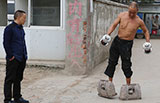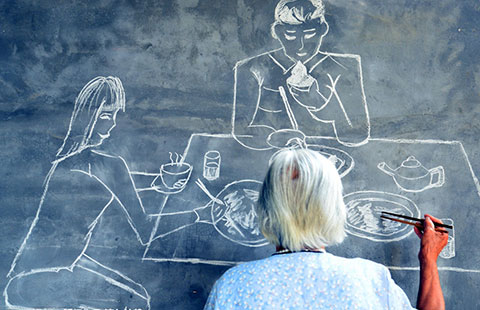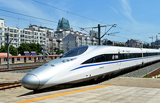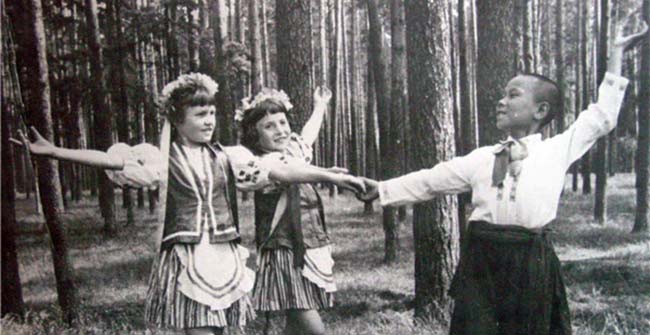Coal country yields riches of past
By Harvey Morris (China Daily Europe) Updated: 2015-10-30 07:33
|
A tourist from New Zealand with a local resident at Hukou. Wang Wenlan / China Daily |
In China's Shanxi province, areas best known for hardscrabble mining have yielded archaeological treasures that make a visit worthwhile
On the walls of a former factory building in the shadow of the medieval walls of the Chinese city of Pingyao, a fading slogan extols the proletarian virtues of hard work, efficiency and safety first.
The workers are long departed and, in a Chinese example of a familiar trend in urban renewal, the old factory now provides exhibition space for cultural events such as the annual Pingyao International Photography Festival.
The walled city is at the geographical heart of China's northern Shanxi province, an area the size of England and Wales combined, with a population of nearly 36 million and an economy founded on coal. It also contains a heavy concentration of the country's cultural and archaeological treasures, dating from the emergence of Chinese civilization along the Yellow River more than four millennia ago to more recent relics of war and revolution.
Until recent years, the reality for many miners in China's biggest coal-producing province was bleak. Unregulated mining by small producers, many of them private speculators, fed China's inexhaustible appetite for raw materials but also left a legacy of child labor, environmental degradation and industrial disasters.
More than 270 people died in a mudslide at a Shanxi iron-ore mine in 2008, and the year before the Shanxi city of Linfen topped a blacklist of the most polluted places in the world. These proved to be a turning point. After earlier faltering attempts to control the freewheeling mine barons, the provincial authorities finally stepped in to nationalize their holdings. Smaller mines and associated polluting industries were shut in a strategy that, coupled with cleaner energy policies nationwide, led to fewer deaths and cleaner skies.
It sounds like a tough sell, particularly in terms of luring Western visitors. But for those interested in the evolution of Chinese history and culture, the province is a potential treasure trove. Aside from its established heritage sites, new finds are being made in the fertile loess sediment of the Yellow River plateau in the south that offer fresh insights into the origins of Chinese civilization.
The malleable soil, now leveled into terraced fields, made an excellent environment for building underground dwellings and cliffside caves from prehistoric times onwards.
Pingyao is one of three Shanxi destinations designated as a World Heritage Site by UNESCO, which describes it as an exceptionally well-preserved example of a traditional Han Chinese city. The grid of narrow streets behind 3.4 kilometers of imposing walls dates to the 14th century.
The focus is the ancient government building, containing a court, tax houses and other administrative buildings that reflect a Chinese imperial tradition that lasted into the 20th century. The offices and homes of bankers who set up shop in the 19th century are among the protected wooden buildings.
The charm of Pingyao is that a lively market and the small workshops and homes near the ancient walls give it the feel of a living city. Artisans have revived the skills of Tuiguang lacquer work to produce traditional boxes and screens and functional modern furniture. With tourism in mind, Pingyao has a street of noisy bars, but better perhaps to head for the tranquility of a traditional courtyard restaurant.
Shanxi stands at the salty end of the varied Chinese culinary spectrum. Vinegar is regarded as an elixir, and the noodle is king - the sliced noodle, the knife-cut noodle, the scissor-cut noodle. A Shanxi noodle virtuoso will take a two and a half kilogram lump of dough and a handful of flour and, in a few minutes of twisting and twirling too fast for the eye to follow, will transform it into a 12-kilometer length of diaphanous thread.
A banquet setting might include a syringe-size vial with a miniature straw protruding. What is it? "Old" vinegar. What to do with it? Drink it as a restorative aperitif.
Most visitors to China have heard of the Terracotta Warriors of Xi'an but how many know of the remarkable Big Iron Oxen of Pujindu? These four magnificent solid cast-iron beasts, weighing up to 75 tons each, once served to anchor a wooden bridge at an important Yellow River salt-exporting port during the Tang Dynasty (AD 618-907).
The river has changed course many times since then. Although discovered in the mud by locals in the 1970s, the oxen first went on display on a raised outdoor plinth in 2005. Even more remarkable than the oxen, cast locally using the lost-wax technique, are the male figures that accompany them. Their fluid muscles, acrobatic stance and knowing expressions are reminiscent of Rodin but created more than a millennium ahead of the French master.
At Hukou, the Yellow River divides Shanxi, "west of the mountains", from the province of Shaanxi, "the land west of Shan". There, it thunders through a narrow gorge, a favorite spot for Chinese trippers. Although the colorfully dressed muleteers who ferry visitors down to the falls swear they see many Western tourists, there were few in evidence in late September.
According to Wang Wei, head of archaeology at the Chinese Academy of Social Sciences, experts have now concluded that the 2.8 million square meter site was the seat of the 3rd millennium BC Emperor Yao, a previously mythical ruler lauded in later Confucian texts for his benevolence and diligence. "The site has the earliest kingdom relics we've found in the middle reaches of the Yellow River," Wang announced.
Some of the city that lies beneath the loess has been uncovered to reveal elite tombs and other urban construction dating back to 4,200 BC. A decade ago, archaeologists located the remains of an ancient observatory - China's oldest - that matched Emperor Yao's legendary reputation as an astronomer king. Experts have recreated 13 pillars that once directed the sun's rays at midsummer and the solstices. The site is immediately reminiscent of Stonehenge, where ancient Britons erected their bluestone circle in the same era.
A visit to Shanxi is a visit to China's ancient past, whose civilizing and even religious traditions have re-emerged as models in the modern state. Outside Yuncheng, at the largest Temple of Guan Yu, the 2nd century AD general deified as the Taoist god of war, young and old kneel to offer incense at a state-protected shrine reconstructed in the 18th century.
Elsewhere, there are reminders of a more recent turbulent past. In a quiet corner of Pingyao, a uniformed and decorated octogenarian, Cun Lishen, was holding court. His latest medal commemorates this year's 70th anniversary of China's victory over Japan. He was 12 when he joined the militia and was at the fall of Nanjing. Fingering a deep bullet scar in his forehead, he recalls killing the first of his enemies at 13, one of 32 to die at his hands. His wife smiles lovingly at a story she has heard many times before.
At the Li family courtyard north of Yuncheng - in reality more a small village than a courtyard - the Lis presided as businessmen and benefactors until almost the middle of the 20th century. The scion of the family raised children there with his British wife around the time of World War I. A solid door with a complex lock mechanism guards the entrance to one of the elegant courtyards. Sometime in the past, some unwelcome visitors lost patience with the lock and hammered a ragged hole into the woodwork. They were a squad of occupying Japanese soldiers. According to a caption posted by the door, the stout barrier held.
Harvey Morris is a veteran journalist who has worked for Associated Press, Reuters, The Independent and the Financial Times. To contact the author: harveymorris@outlook.com
For China Daily
- NPC considers law aimed at charity transparency
- South China Sea ruling 'null and void', says ministry
- Couples face wait for 'second-child' policy
- New laws turn lens on domestic film industry
- Average Beijinger read 9 books in 2014: survey
- Top legislature considers draft charity law
- Senior Tibet legislator expelled from CPC, public office
- Family planning policy sees big overhaul
- Nation aims to maintain strong growth rates in the next 5 years
- Overseas help leads to more fugitives returned








